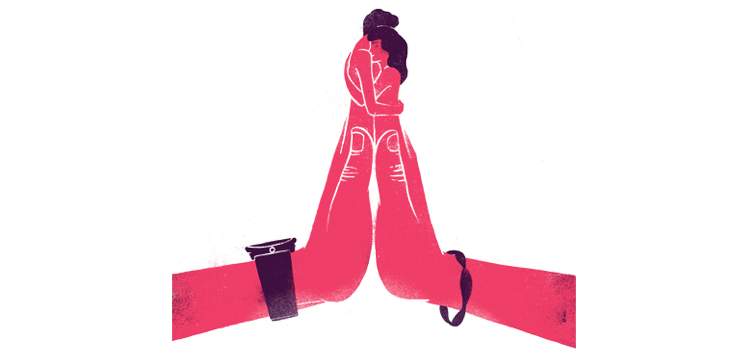I love to watch people touch the ones they love. When I witnessed the birth of my beloved friends’ daughter, the most poignant moment was watching the first-time father tear his shirt off and hold the minutes-old infant to his bare, receptive chest. Skin on skin, heart to heart. At our best, we intuitively use touch to span the distance between us. Two separate bodies and minds, me and you, become an “us” when we embrace. That which is broken—a promise, a skinned knee, even a heart—is coaxed toward fullness again in the incubator of a loved one’s arms.
One study noted that dining companions in France touched each other an average of 110 times during the meal, but Americans only twice.
Since touching each other brings a multitude of emotional, physical, and social health benefits you’d think we’d be cuddling all the time. Yet our culture is touch-deprived. One study noted that dining companions in France touched each other an average of 110 times during the meal, but Americans only twice. The next time you are someplace romantic, notice how few people are holding hands. My friend says he wishes I’d never pointed this out to him. Now everywhere he goes he sees the distance between loved ones, and how rare real contact can be in our busy, distracted world.
I have a patient who suffered serious injuries in an explosion. While she lay in the ER being tended to by gruff medical personnel, all she wanted was for her husband to hold her hand. When he pulled away, that hurt her more than the lacerations did. Touch can be a nonverbal “I love you” that somehow makes everything okay, or, if not okay, at least a little better. Researchers Jim Coan and Richard Davidson used fMRI to show that when people were told to anticipate a painful blast of white noise there was heightened activity in the threat/stress response areas of the brain. However, if their romantic partner stroked their arm while they waited, they showed no reaction to the impending stressor.
When you are sad, anxious, or having a generally lousy day, don’t you just want a hug? Dacher Keltner of UC Berkeley’s Greater Good Science Center calls touch “the primary language of compassion.” Touch calms cardiovascular stress, triggers oxytocin (the “love hormone”), and activates the vagus nerve. In a fascinating study, Keltner separated two people from each other with a barrier. One subject put their arm through an opening while the other was instructed to convey various emotions using only a one-second touch on the unseen stranger’s arm. The person being touched identified compassionate touch correctly 60% of the time—the odds of getting it right by simply guessing, they calculated, was 8%. Think about that. We can convey compassion toward another in a single second of touch.
So why do we hold back? Enjoying touch is natural but we may learn to resist loving touch after suffering unpleasant experiences. Or perhaps we simply feel awkward with affectionate display because hugs and kisses between our standoffish parents were nonexistent. Nonverbal contact nurtures, reassures, and connects, so it follows that increasing mindful touch can improve relationships. Indeed, marital satisfaction research reveals that happy couples share similar touching behavior. When a partner shrugs off our advances we feel rejected, needy, and lonely. Beware: The absence of a goodnight kiss rings far louder than the muttered “goodnight.”
So touch more, and touch often. On a recent weekend trip I looked for examples of how contact makes us feel safe. Here is what I saw: My friend’s blonde stepson, negotiating his new family, gently holds his guinea pig to his body, stroking the fur of his constant friend, desperate to find a center in the middle of change; a backpack-and-skateboard-laden couple on the ferry, journeying to places unknown, kiss and nibble as we cross the Strait of Georgia. Gnarled and ropey hands, now too twisted for wedding rings, entwine as an elderly couple look both ways before crossing, just as they’ve been doing for a half-century. Leaning my head back onto my sweetheart’s chest, his arms circling me, we watch our elders and hope we will still be holding hands decades from now, buffered from whatever painful blasts this world has in store for us.
This article appeared in the December 2015 issue of Mindful magazine.






